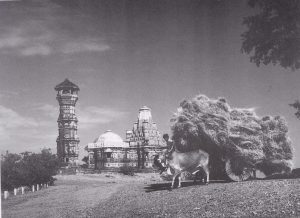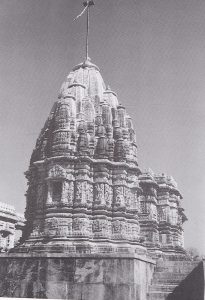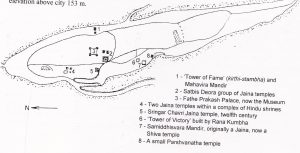Chittorgarh
 Nothing will be said here about the many battles and the bloodshed associated with Chittorgarh Fort. In the end, after more than a thousand years, this abruptly rising plateau remotely shaped like a whale when seen from the air, has found peace.
Nothing will be said here about the many battles and the bloodshed associated with Chittorgarh Fort. In the end, after more than a thousand years, this abruptly rising plateau remotely shaped like a whale when seen from the air, has found peace.
Thus, a photograph emanating today’s peaceful atmosphere of the Fort has been chosen to head this chapter. It shows the Kirti Stambha or Tower of Fame that was built in the twelfth century by a Digambara merchant named Fija and dedicated to Adinatha. Erected on about the highest elevation of the plateau and rather removed from other buildings, it rises to a height of 22 8 metres: the Mahavira Temple next to it is of a later date.
Some centuries after, in 1440, Rana Kumbha, probably inspired by the Jaina Tower of Fame, ordered the building of his famous Tower of Victory. Which of the two towers is architecturally the more elegant, is an open question; some experts favour the Jaina Kirthi Stambha.
Each of the seven storeys of the Tower of Fame is differently moulded and carved. A  winding staircase leads up to the top pavilion, however, the original statue of the first Tirthankara for which it was designed is missing. Both the Kirthi Stambha and the Mahavira Temple beside it, which is thought to have been built in the thirteenth century and restored in recent times, stand under the jurisdiction of the Archacological Survey of India.
winding staircase leads up to the top pavilion, however, the original statue of the first Tirthankara for which it was designed is missing. Both the Kirthi Stambha and the Mahavira Temple beside it, which is thought to have been built in the thirteenth century and restored in recent times, stand under the jurisdiction of the Archacological Survey of India.
You cannot save the world,
but you can cultivate your garden,
which the Jainas know to be the soul.
-Michael Tobias
Chittorgarh Fort. One of the profusely sculptured Shvetambara temples of the Satbis Deora group. In the rear the Museum.

Map of Chittorgarh Fort. Length 5.6 km, elevation above city 153 m.
